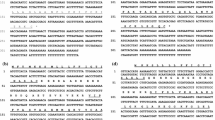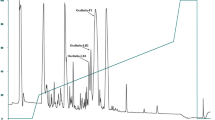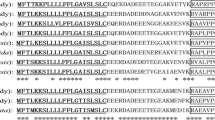Abstract
Amphibian skin is a rich and unique source of novel bioactive peptides most of which are endowed with either antimicrobial or pharmacological properties. Here, we report the identification and structural characterization of a novel peptide, named senegalin, which possesses both activities. Senegalin is a hexadecapeptide amide (FLPFLIPALTSLISSL-NH2) of unique primary structure found in the skin secretion of the African running frog, Kassina senegalensis. The structure of the biosynthetic precursor of senegalin, deduced from cloned skin cDNA, consists of 76 amino acid residues and displays the typical domain organization of an amphibian skin peptide precursor. Both natural senegalin and its synthetic replicate displayed antimicrobial and myotropic activities. Senegalin was active against Staphylococcus aureus (MIC 50 μM) and Candida albicans (MIC 150 μM) but was non-haemolytic at concentrations up to and including 150 μM. In contrast, senegalin induced a dose-dependent contraction of rat urinary bladder smooth muscle (EC50 2.9 nM) and a dose-dependent relaxation of rat tail artery smooth muscle (EC50 37.7 nM). Senegalin thus represents a prototype biologically active amphibian skin peptide and illustrates the fact that amphibian skin secretion peptidomes continue to be unique sources of such molecules.







Similar content being viewed by others
References
Allen JA, Roth BL (2011) Strategies to discover unexpected targets for drugs active at G protein-coupled receptors. Annu Rev Pharmacol Toxicol 51:117–144
Amiche M, Galanth C (2011) Dermaseptins as models for the elucidation of membrane-acting helical amphipathic antimicrobial peptides. Curr Pharm Biotechnol 12:1184–1193
Arnold K, Bordoli L, Kopp J, Schwede T (2006) The SWISS-MODEL workspace: a web-based environment for protein structure homology modelling. Bioinformatics 22:195–201
Azevedo Calderon L, Silva Ade A, Ciancaglini P, Stábeli RG (2011) Antimicrobial peptides from Phyllomedusa frogs: from biomolecular diversity to potential nanotechnologic medical applications. Amino Acids 40:29–49
Baker DD, Chu M, Oza U, Rajgarhia V (2007) The value of natural products to future pharmaceutical discovery. Nat Prod Rep 24:1225–1244
Bevins CL, Zasloff M (1990) Peptides from frog skin. Annu Rev Biochem 59:395–414
Chen H, Wang L, Zeller M, Hornshaw M, Wu Y, Zhou M, Li J, Hang X, Cai J, Chen T, Shaw C (2011) Kassorins: novel innate immune system peptides from skin secretions of the African hyperoliid frogs, Kassina maculata and Kassina senegalensis. Mol Immunol 48:442–451
Chen T, Reid CN, Walker B, Zhou M, Shaw C (2005) Kassinakinin S: a novel histamine-releasing heptadecapeptide from frog (Kassina senegalensis) skin secretion. Biochem Biophys Res Commun 337:474–480
Clarke BT (1997) The natural history of amphibian skin secretions, their normal functioning and potential medical applications. Biol Rev Camb Philos Soc 72:365–379
Conlon JM, Kolodziejek J, Nowotny N (2004) Antimicrobial peptides from ranid frogs: taxonomic and phylogenetic markers and a potential source of new therapeutic agents. Biochim Biophys Acta 1696:1–14
Duda TF Jr, Vanhoye D, Nicolas P (2002) Roles of diversifying selection and coordinated evolution in the evolution of amphibian antimicrobial peptides. Mol Biol Evol 19:858–864
Erspamer V (1994) Bioactive secretions of the integument, Amphibian Biology. In: Heatwole H, Barthalmus T (eds) The integument, vol 1. Surrey Beatty and Sons, Chipping Norton, pp 178–350
Haney EF, Hunter HN, Matsuzaki K, Vogel HJ (2009) Solution NMR studies of amphibian antimicrobial peptides: linking structure to function? Biochim Biophys Acta 1788:1639–1655
Levoye A, Dam J, Ayoub MA, Guillaume JL, Jockers R (2006) Do orphan G-protein-coupled receptors have ligand-independent functions? New insights from receptor heterodimers. EMBO Rep 7:1094–1098
Maloy WL, Kari UP (1995) Structure-activity studies on magainins and other host defense peptides. Biopolymers 37:105–122
Matutte B, Knoop FC, Conlon JM (2000) Kassinatuerin-1: a peptide with broad-spectrum antimicrobial activity isolated from the skin of the hyperoliid frog, Kassina senegalensis. Biochem Biophys Res Commun 268:433–436
Pukala TL, Bowie JH, Maselli VM, Musgrave IF, Tyler MJ (2006) Host-defence peptides from the glandular secretions of amphibians: structure and activity. Nat Prod Rep 23:368–393
Simmaco M, Mignogna G, Barra D (1998) Antimicrobial peptides from amphibian skin: what do they tell us? Biopolymers 47:435–450
Tempone AG, Melhem MdeSC, Prado FO, Motoie G, Hiramoto RM, Antoniazzi MM, Haddad CFB, Jared C (2007) Amphibian secretions for drug discovery studies: a search for new antiparasitic and antifungal compounds. Lett Drug Des Discov 4:67–73
Tyler MJ, Stone DJM, Bowie JH (1992) A novel method for the release and collection of dermal glandular secretions from the skins of frogs. J Pharmacol Toxicol Methods 28:199–200
Vanhoye D, Bruston F, Nicolas P, Amiche M (2003) Antimicrobial peptides from hylid and ranin frogs originated from a 150-million-year-old ancestral precursor with a conserved signal peptide but a hypermutable antimicrobial domain. Eur J Biochem 70:2068–2081
Wang H, Wang L, Zhou M, Yang M, Ma C, Chen T, Zhang Y, Zeller M, Hornshaw M, Shaw C (2012) Functional peptidomics of amphibian skin secretion: a novel Kunitz-type chymotrypsin inhibitor from the African hyperoliid frog, Kassina senegalensis. Biochimie 94:891–899
Wang L, Smyth A, Johnsen AH, Zhou M, Chen T, Walker B, Shaw C (2009a) FMRFamide-related peptides (FaRPs): a new family of peptides from amphibian defensive skin secretions. Biochem Biophys Res Commun 383:314–319
Wang L, Zhou M, Lynch L, Chen T, Walker B, Shaw C (2009b) Kassina senegalensis skin tachykinins: molecular cloning of kassinin and (Thr2, Ile9)-kassinin biosynthetic precursor cDNAs and comparative bioactivity of mature tachykinins on the smooth muscle of rat urinary bladder. Biochimie 91:613–619
Wang L, Zhou M, McGrath S, Chen T, Gorman SP, Walker B, Shaw C (2009c) A family of kassinatuerin-2 related peptides from the skin secretion of the African hyperoliid frog, Kassina maculata. Peptides 30:1428–1433
Zhang R, Zhou M, Wang L, McGrath S, Chen T, Chen X, Shaw C (2010) Phylloseptin-1 (PSN-1) from Phyllomedusa sauvagei skin secretion: a novel broad-spectrum antimicrobial peptide with antibiofilm activity. Mol Immunol 47:2030–2037
Zhou M, Wang L, Owens DE, Chen T, Walker B, Shaw C (2007) Rapid identification of precursor cDNAs encoding five structural classes of antimicrobial peptides from pickerel frog (Rana palustris) skin secretion by single step “shotgun” cloning. Peptides 28:1605–1610
Author information
Authors and Affiliations
Corresponding authors
Additional information
H. Wang and R. Li contributed equally to the work.
Rights and permissions
About this article
Cite this article
Wang, H., Li, R., Xi, X. et al. Senegalin: a novel antimicrobial/myotropic hexadecapeptide from the skin secretion of the African running frog, Kassina senegalensis . Amino Acids 44, 1347–1355 (2013). https://doi.org/10.1007/s00726-013-1470-8
Received:
Accepted:
Published:
Issue Date:
DOI: https://doi.org/10.1007/s00726-013-1470-8




